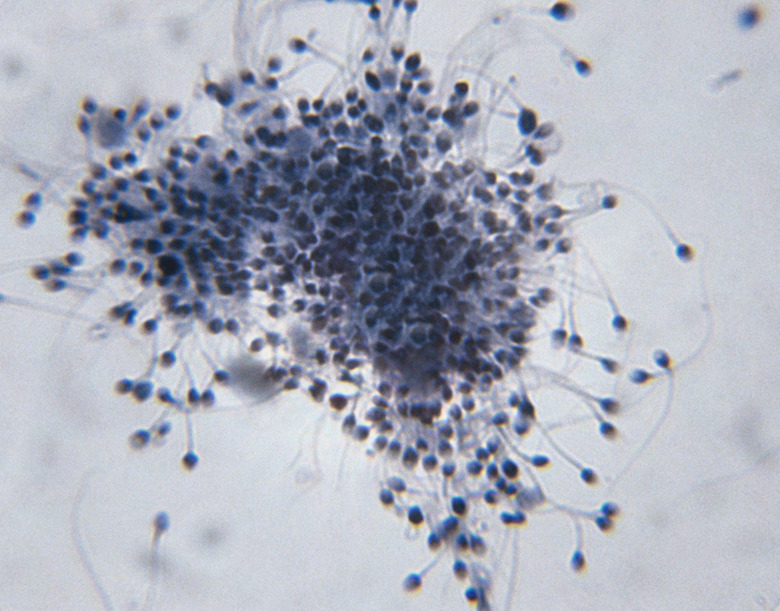What Do Basal Bodies That Form Cilia And Flagella Originate From?
Many microorganisms and cell types contain cilia or flagella, which are hair-like or whip-like structures projecting from the cell wall into the external environment. Cilia and flagella function to propel a motile cell, move external materials around a fixed cell or act as non-motile sensory elements.
Cilia and flagella have the same basic structure and differ only in that flagella are longer than cilia. They also differ with exactly how they move and what cells they're found on. Both types of structures are rooted to the cell at the basal body (also called a kinetosome), which is a specialized form of a structure called a centriole.
Centrioles
Centrioles
A basal body is a centriole, which is a cylinder-shaped structure composed of microtubules that in turn contain up to 13 protofilaments surrounding a hollow center. Basal bodies are the organelles needed to form cilia and flagella. The protofilaments are polymers of the protein tubulin.
The microtubules in a basal body appear as a set of nine triplets. Each triplet contains three microtubules, labeled A, B and C, attached to each other along their lengths.
The nine triplets form a hollow cylinder situated just below the cell membrane. A basal body serves as the root from which flagella and cilia sprout and anchor to the cell.
Microtubule Organizing Center
Microtubule Organizing Center
The basal body is an example of a microtubule-organizing center, or MTOC. These structures are unique because they consist of the gamma form of tubulin. This simply means that the tubulin has a slightly different structure compared to alpha and beta tubulin, which allows it to function differently.
The tubulin proteins in flagella and cilia are of the alpha and beta variety. As an MTOC, the basal body stabilizes the microtubules and supports their movement. The gamma tubulin of an MTOC joins with other proteins to form ring complexes that provide a binding site for the microtubules.
The Transition Zone
The Transition Zone
The basal body transitions into a structure called an axoneme, which forms the skeleton of the flagellum or cilium. Within the transition zone, the C microtubules of the basal body terminate. The remaining nine sets of A and B tubules extend through the transition zone and help form the axoneme.
Motile cilia and flagella, such as those found in the human trachea and the flagellum found on sperm cells, have axonemes that contain two additional microtubules running up the central axis. Non-motile cilia lack the central microtubules.
Basal Body Functions
Basal Body Functions
Basal bodies perform several functions important to cilia and flagella activities. The nine basal body microtubules provide the template for building the axoneme. The basal body also orients and positions the cilium or flagellum, which is critical to the correct movement of fluids within the axoneme.
Basal bodies regulate the entry of proteins into the axoneme and play a role in cell division. Any basal body malfunctions can lead to various diseases.
Basal Body Diseases
Basal Body Diseases
One such disease is called Joubert Syndrome. Caused by various mutations in basal body and cilia genes, cilia and basal body formation is abnormal in the developing fetus. Without proper function of cilia during development, areas of the body and cells in the fetus don't develop properly.
These signaling and developmental malfunctions that lead to the symptoms of this disease including severely underdeveloped and abnormal motor skills, malformed cerebellum, lack of muscle control, hormonal issues, droopy eyelids and more.
Another example of a basal body disorder is Meckel syndrome. Caused by mutations in genes that allow basal bodies to form and function, it results in death for those affected. It's thought to be lethal because of inactive/malformed cilia that don't properly circulate amniotic fluid during development.
Cite This Article
MLA
Finance, Eric Bank, MBA, MS. "What Do Basal Bodies That Form Cilia And Flagella Originate From?" sciencing.com, https://www.sciencing.com/basal-bodies-form-cilia-flagella-originate-from-23403/. 21 May 2019.
APA
Finance, Eric Bank, MBA, MS. (2019, May 21). What Do Basal Bodies That Form Cilia And Flagella Originate From?. sciencing.com. Retrieved from https://www.sciencing.com/basal-bodies-form-cilia-flagella-originate-from-23403/
Chicago
Finance, Eric Bank, MBA, MS. What Do Basal Bodies That Form Cilia And Flagella Originate From? last modified August 30, 2022. https://www.sciencing.com/basal-bodies-form-cilia-flagella-originate-from-23403/
